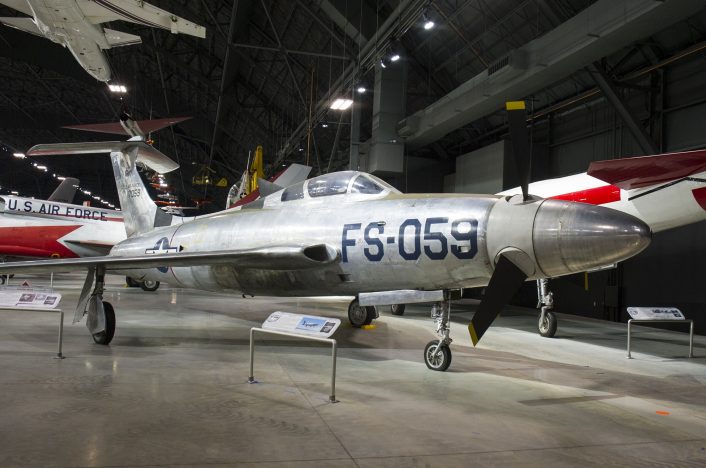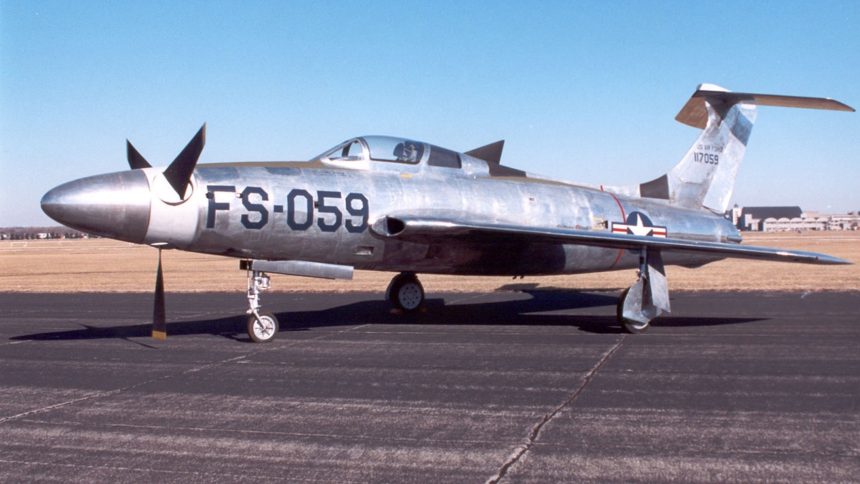The XF-84H was an ambitious project to reverse-engineer a jet-powered F-84 into a prop-driven aircraft capable of achieving near-jet performance.
The Need for the Screech
The United States Navy initially had an interest in a single-seat turboprop-powered carrier fighter-bomber aircraft that would not need catapult assistance and was compatible with the current fleet of aircraft carriers, and the United States Air Force saw the benefits of an aircraft utilizing shorter runways and able to operate over greater ranges than jet-powered fighter-bomber, which resulted in Republic’s AP-46 proposal.
The project, directed by Joseph Freeman, called for the aircraft to carry a 4,000 lb. externally stored ordinance load as well as gun armament. Initially the prototype aircraft was designated the XF-106, but was later changed to the XF-84H, designating it as a Republic F-84 variant. Orders were placed for three prototype aircraft, one by the Navy, two by the Air Force. The Navy soon lost interest in the project and their prototype was cancelled, however the Air Force continued the project by funding the two prototypes they had ordered in December 1952.
Two Prototypes
Developed from the Republic F-84F Thunderstreak, instead of using the conventional jet engine, the XF-84H derived its power from an Allison XT40-A-1 turboprop engine assembly that consisted of two T38 power sections coupled and located centrally in the aircraft, housed behind the cockpit in an expanded fuselage. Two 18 ft. long shafts extended from the engines to a reduction gearbox that transferred power to the attached 12 ft diameter propeller at the nose of the aircraft.
Since the engine and propeller ran at a constant speed, thrust was adjusted by changing blade pitch of the propeller and additional thrust was available through engine exhaust as an afterburner was installed. With the use of the afterburner, power was thought to be in the neighborhood of 7,200 horsepower, however the afterburner was never used, and the engine was utilized at its rate of 5,850 hp without it. The XF-84H would be the first turboprop powered aircraft with an afterburner.
Other modifications included modified wing roots to accommodate intake ducting as well as a T-type horizontal tail to avoid prop wash, along with a vertical fin for anti-torque purposes mounted just behind the cockpit, as the aircraft had a tendency to constantly roll. Other measures to combat the powerful torque of the three square-tipped propeller blades included moving the left leading edge intake 12 inches forward compared to the right intake, as well as flaps with differential operation for left and right.
As a precaution against engine problems, the XF-84H was the first aircraft equipped with retractable ram air turbine that could be extended out into the airstream to provide electrical and hydraulic power in the event of engine failure. In reality the aircraft had so many engine issues that the air turbine was routinely deployed in the extended position during flight tests as a safety measure.
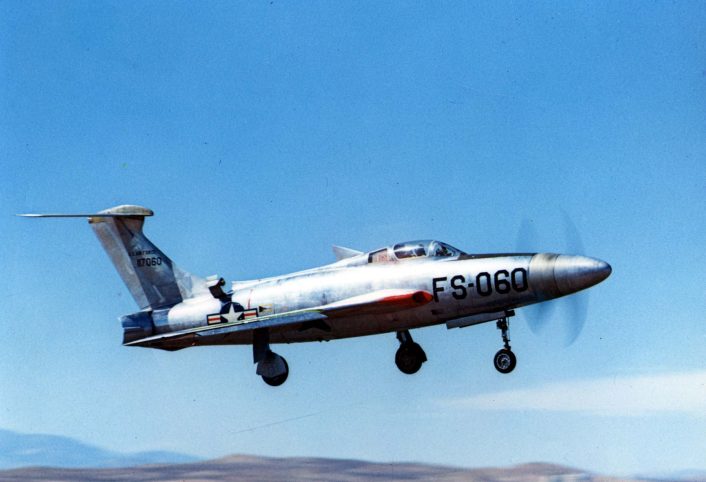
The XF-84H had a wingspan of 33 ft 6 in (about one inch less than the F-84F) and was 51 ft 6 in long, longer than the F-84F’s length of 43 ft 4.75 in on account of the huge propeller spinner attached to the front of the aircraft. The XF-84H weighed in empty at over 17,800 lb compared to 13,830 lb for the F-84F, mainly due to the heavy Allison coupled engine assembly. Top speed of the XF-84H was theorized at 670 mph, and unofficially the aircraft reached 623 mph, but a top speed of 520 mph seems to be the official data claimed by the Air Force. It did hold the title of the fastest single-engine propeller-driven aircraft until unseated in 1989 by a modified Grumman F8F Bearcat. Range was over 2,000 miles for the XF-84H the service ceiling 40,000 ft.
Sickening Sounds
The two prototype aircraft were shipped by train from Farmingdale, New York, where the manufacturing plant of Republic was located, to Edwards Air Force Base, California. Test flights began in July 1955 and continued into October 1956. Problems soon became apparent, as the Allison engine would take 30 minutes to warm-up, not an effective time frame for a military combat aircraft. Vibration issues from the propeller as well as problems with the pitch gearing mechanisms for the propellers caused failures.
A total of twelve test flights were flown, with all but one ending in an emergency landing. Pilots complained the aircraft was prone to “snaking” — losing longitudinal stability. The aircraft became very difficult to handle once the speed of 450 mph was reached. One Republic test pilot, Lin Hendrix, flew the aircraft once and told the project engineer “You aren’t big enough and there aren’t enough of you to get me in that thing again.”
The balance of the test flights would be conducted by Republic test pilot Hank Beaird. Engine failures, vibration issues, hydraulic failures, and nose gear issues seemed to plaque the test flights. Only a total of 6 hours and 40 minutes of flight time were logged in the pair of XF-84H aircraft.
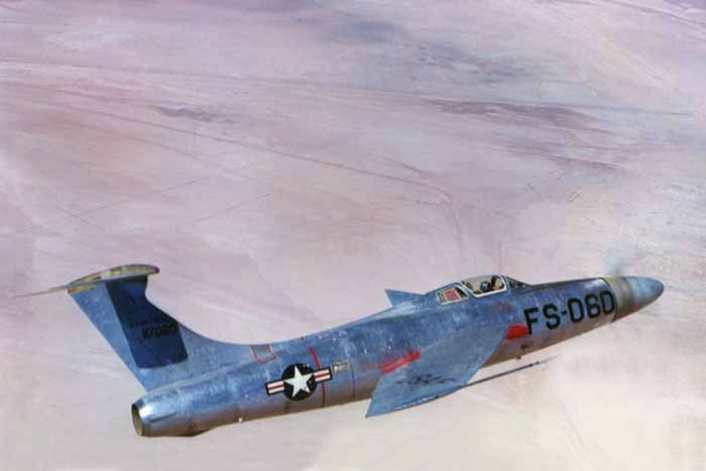
However, outside of being unreliable and a challenge to fly, the XF-84H had an even more sinister side. It was noisy to the extreme. The aircraft never broke the sound barrier in flight, but the large squared-off propeller blades would travel constantly faster than the speed of sound at around 900 mph at the outer extremes of the blades. This produced a constant stream of sonic booms that created shock waves that radiated hundreds of yards. It was reported that during ground run-ups of the engine, the aircraft could be heard 25 to 45 miles away. The shock waves from this aircraft could knock a man down. The dual turbine sections of the T40 engine also added to the din.
Hence the aircraft became known as the “Thunderscreech”, or “Mighty Ear Banger”. It is said to be one of, if not the, loudest aircraft in the world. The noise was so intense ground crews had to operate from a distance and use signal flags and lights to communicate. But that was not the only effect the noise had on crewmembers and those nearby.
At one point during testing, a Thunderscreech was tied down next to a Douglas C-47. It was assumed the C-47 was empty at the time; however that was not the case. The crew chief was inside sweeping out the C-47 when the engine was fired up and ran for about 30 minutes on the XF-84H. When the XF-84H was shut down, a clanging sound was heard coming from the back of the C-47. The crew chief had been incapacitated by the intense noise and was on his back flailing his limbs about on the floor of the C-47.
Nausea, vomiting, and severe headaches after run-ups were reported by crews who had been in the vicinity of the aircraft. One Republic engineer suffered a seizure from the shock waves generated by the propellers. The noise of the aircraft also severely interfered with operations at the control tower at Edwards Air Force Base with the extreme vibrations affecting sensitive components, forcing communications between the tower and the crew of the aircraft with light signals. Eventually Republic was ordered to tow the offending aircraft far out onto Rogers Dry Lake before any engine run-ups.
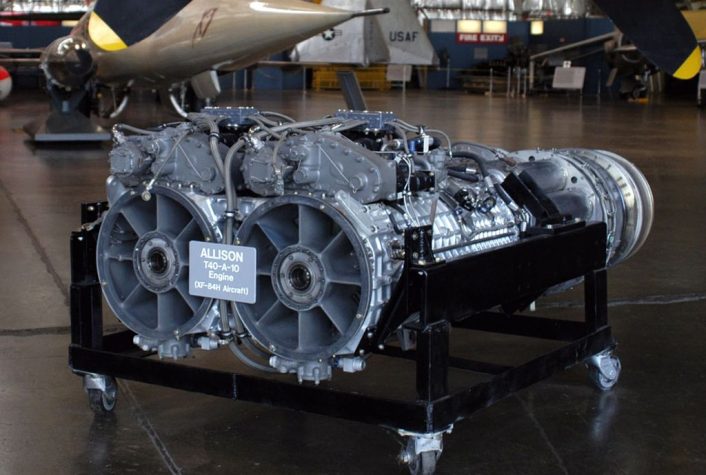
Silent Now
Two prototypes of the XF-84H were produced, numbers 51-17059 and 51-17060. These aircraft were only flown by Republic test pilots; no Air Force personnel flew the aircraft since it never made it out of the manufacturer’s proving flights. With failures of equipment and the engines seemingly impossible to overcome, as well as the aircraft not meeting intended speeds and performance, the program was finally cancelled in the fall of 1956.
Aircraft 17060 appears to have been scrapped soon after cancellation of the project, after only making four flights. Aircraft 17059 was placed on a pole in Bakersfield, California as a gate guard at Meadows Field Airport. The aircraft was moved in the 1990’s to Ohio and restored to static display condition by volunteers at the 178th Fighter Wing of the Ohio National Guard. It is now on display at the National Museum of the United States Air Force at Wright-Patterson Air Force Base in Dayton, Ohio.
